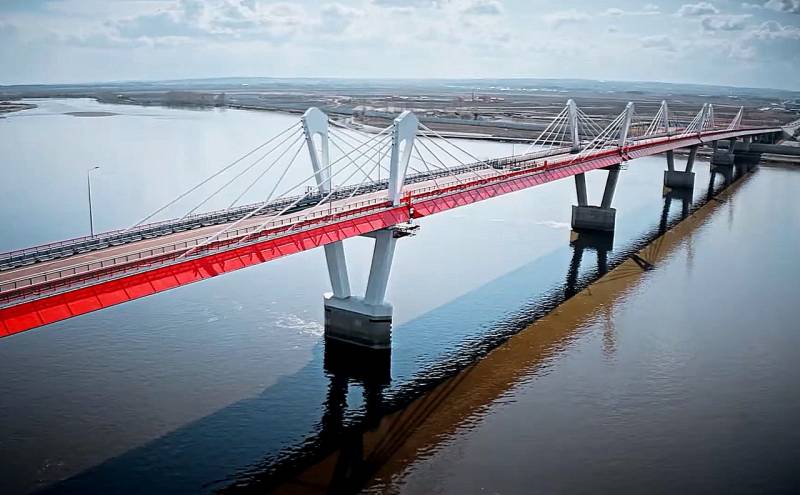Blagoveshchensk-Heihe Bridge: Road to the Trade Future
The very idea of building a bridge across the Amur River near the city of Blagoveshchensk has a rather long history. For a long time, this issue was on an ongoing basis in the field of view of bilateral relations between the Russian Federation and the People's Republic of China. In addition, the possibility of construction was discussed by representatives of the regional authorities of both countries.
It should be noted that the problems associated with the construction of the bridge did not always lie in the financial plane, at one time the Chinese side offered to fully take over the financial side of the issue. Sometimes disagreements between the PRC and the Russian Federation concerned the design features of the new structure. In 2002, China proposed to build not a road, but a railway bridge. Our side was interested in a bridge crossing that could be used by both road and rail transport. Also, a rather significant barrier to the promotion of this project was the idea that, from the point of view of economic there is no need for efficiency in building a bridge. Representatives of many shipping companies and the commercial port of Blagoveshchensk spoke in a similar vein, suggesting that the appearance of a bridge crossing would negatively affect their income. Many experts disagreed with their position, stating that the appearance of the bridge will play the role of a certain driver for tourism and interstate trade.
In 2015, an intergovernmental agreement was signed, which launched a large construction project in December 2016. Plenipotentiary Representative of the President of the Russian Federation in the Far Eastern Federal District Yuri Trutnev subsequently emphasized that the uniqueness of this project lies in the fact that it was possible to implement it without attracting budgetary funds. It was built as part of a concession model, which involves the construction of an object at the expense of an investor, after which the company involved in the implementation of the project gets the opportunity to operate the object on a reimbursable basis, collecting income for its own benefit. Back in the spring of 2015, the Amur Bridge Construction Company (China) and Most OJSC (Russia) established a joint venture that was engaged in investment management, design, construction, operation and other issues within the project. Experts stated that the funds invested in construction should pay off within 16 years.
It is clarified that the construction work was carried out in parallel by domestic and Chinese specialists. The length of the bridge is 1080 meters. Each side built exactly half - 540 meters each. Parts were erected simultaneously from both sides, their docking took place at the end of May 2019, and in the autumn it was reported that the construction of the bridge was completed. In May 2020, permission was received to put the facility into operation, however, the start of traffic on the bridge was to take place only after the restrictions associated with the coronavirus pandemic were lifted.
On June 10, 2022, the long-awaited opening of the bridge took place, during the event, the first trucks went through the Kani-Kurgan-Heihe checkpoint, eight tractors proceeded to China, the same number of trucks moved towards Russia from the Chinese side.
The Minister of Transport of the Russian Federation Vitaly Savelyev at the opening ceremony of the bridge emphasized that the commissioning of the facility would create conditions for increasing trade with the People's Republic of China along this route (Blagoveshchensk - Heihe), which could reach 1 million tons of cargo per year. Also, the bridge will provide the necessary infrastructure for the advanced development area (TOR) "Priamurskaya", which was formed in 2015. At the beginning of last year, 20 residents were registered in the territory. It is also necessary to pay attention to a curious fact, because within the framework of the Priamurskaya ASEZ, another large cross-border project is being implemented, the total investment in which is estimated at 7,3 billion rubles. We are talking about a cable car that will connect all the same Blagoveshchensk and Heihe. It is scheduled to open this calendar year. If we return to the opening of the bridge and its economic prospects, then, according to Vitaly Savelyev, putting the bridge into operation will reduce transportation costs for business representatives, will enable nearby regions to reduce the export and import route by more than three times and will become a link for the implementation of large joint ventures. investment projects.
To increase the capacity of the new bridge, from January 3, 2023, the international checkpoint (checkpoint "Kani-Kurgan") began to work around the clock. The parties are also actively working on expanding the range of goods turnover. In addition, by now, the terminal has expanded the area for cargo storage, and facilities for all-weather repacking of containers will be built by the end of the year.
It is curious that another major transport project was implemented in Russia last year: the Nizhneleninskoye-Tongjiang railway bridge. The length of the transition exceeds seven kilometers, it is located on the territory of the Jewish Autonomous Region. It is assumed that the new bridge will significantly increase the turnover and competitiveness of domestic business. The new route will send iron ore, coal, mineral fertilizers and other goods to China.
If we return to the topic of our article, then we can summarize it with the words of the Governor of the Amur Region Vasily Orlov, which he said at the opening ceremony of the bridge. The head of the region then said that the opening of the bridge would have a serious impact on the further development of trade and economic relations between the Russian Federation and the People's Republic of China. Taking into account political situation in the world, attempts to economically isolate Russia, this fact is of particular importance for our country.

Information